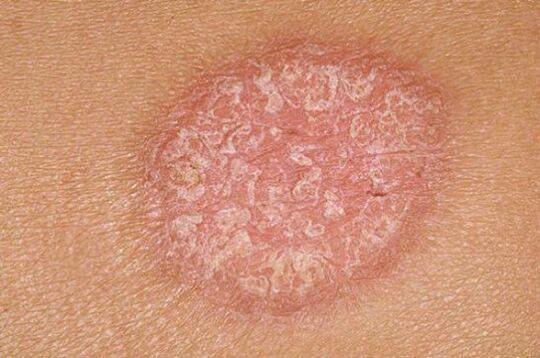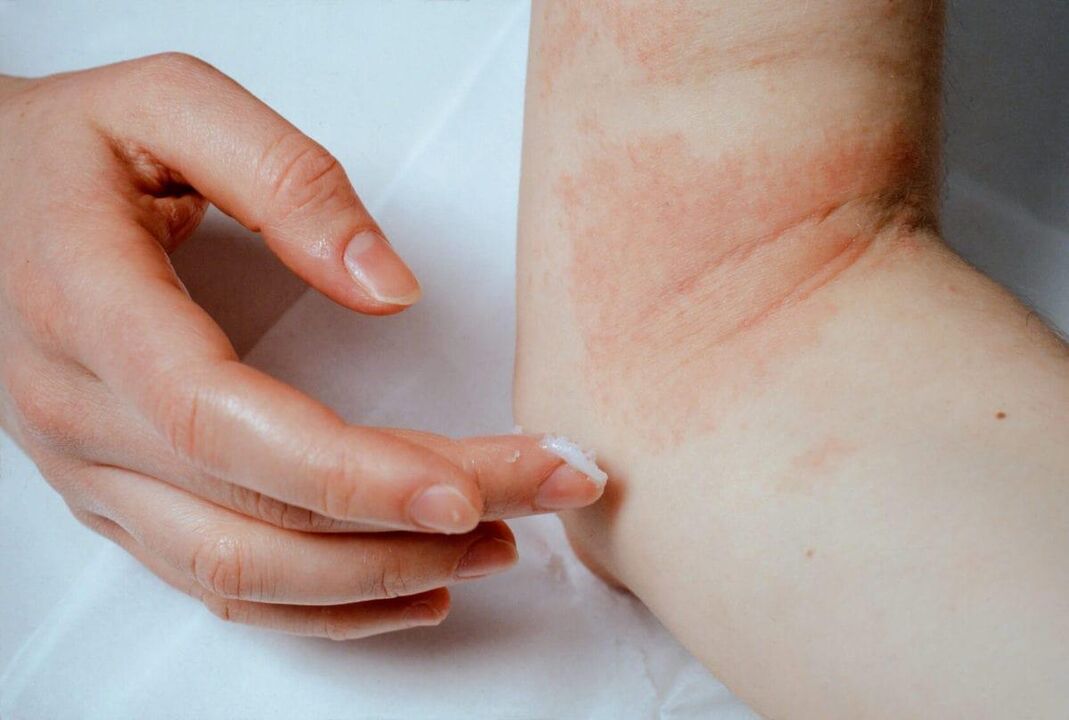Ecorical (vulgar) psoriasis is a chronic skin disease, which is characterized by the appearance of characteristic changes on the skin, a sharp decrease in the quality of life due to the appearance of itching and burning skin, but at the same time does not pose a direct threat to life, while maintaining in most cases throughout its length.
The first signs of psoriasis in most cases are found in childhood or youth, after thirty years the disease, as a rule, does not manifest.About two percent of the population suffers from this disease, although according to some other data, the figure exceeds 6%, but many cases of mild course of the disease are simply not recorded.
Causes

Ordinary common psoriasis is a versatile disease, that is, it does not occur under the influence of a certain cause, but due to the influence of a large number of factors.So it was considered for a long time, until the scientists found out that the genetic anomaly is actually based on the development of the disease.
Violations in the short shoulder of the fifth chromosome are the cause of a change in immune tolerance and under the influence of a number of factors this change can appear in the form of psoriasis.In other words, a genetic anomaly creates a predisposition to the disease, but does not yet guarantee its occurrence.
Factors that can contribute to psoriasis should be called:
- Stress;
- Alcohol and smoking;
- Infectious diseases and foci of chronic infection;
- Endocrine disorders, primarily diabetes;
- Violations of immune tolerance under the influence of various external factors, including poor ecology.
Symptoms and first signs
Occupational psoriasis is the most common form of the disease, it is believed that 90% of all cases of psoriasis falls on vulgar psoriasis.
Psoriasis of the scalp can take place, but often manifestations are observed precisely on the skin.The first changes appear on the skin of the extensor surface of the elbow and knee joints.Then they can spread from the primary foci on the extensor surface of the forearm and on the shoulder, chest and back.
The features of rashes are as follows:
- Black spot;
- There is a white plaque on the surface (looks like a wax plaque);
- Crusts are removed, but not easy;
- After removing the crusts on the surface of the rash, bloody discharge appears, since removal of crusts injures blood vessels.
Rashes for psoriasis are always accompanied by severe itching, sometimes so pronounced that because of it the night sleep is disturbed, which leads to pronounced negative emotions and impaired regime and rest.Labor capabilities are significantly reduced, in connection with which psoriasis without treatment can cause disability.
Ordinary psoriasis in children
In some cases, ordinary psoriasis in children can manifest at the very early age, in this case characteristic clinical manifestations appear, and standard treatment is difficult due to the negative effect of drugs on other organs and systems.
However, ordinary or any other psoriasis in early childhood practically does not develop, in most cases the disease develops in adolescence, and in earlier years it can imitate much more common atopic dermatitis.However, when changes appear on the skin, it is still necessary to consult a doctor as soon as possible to examine and form an accurate diagnosis.
Diagnostic measures
In most cases, the diagnosis of ordinary psoriasis does not cause great difficulties.Characteristic clinical signs make it possible to suspect the presence of the disease, a positive symptom confirms the assumptions, but to make a final diagnosis, it is used to conduct a biopsy of the skin area covered with rashes, where histological changes in the dermis are detected by the disease.
What can you confuse with?
Despite the presence of a characteristic clinical picture, it is not always possible to make a diagnosis only during examination, in some cases it is necessary to differentiate the disease with:
- Seborrheic eczema;
- Red flat lichen;
- Neurodermatitis;
- Atopic dermatitis.
The most effective method of conducting a differential diagnosis is a biopsy of the skin area.The detection of changes characteristic of psoriasis in the skin makes it possible to verify the diagnosis.
Psoriasis treatment
If there was a single scheme of effective treatment of psoriasis, then, probably, all patients could easily get rid of the manifestations of the disease and significantly improve the quality of life, but there are a number of problems in the therapy of this disease, among them it should be called:
- Refusal of patients with treatment with mild and moderate course;
- The difficulty to cope with the situation in a severe course of the disease;
- High cost of effective treatment methods;
- The need for individual selection of therapy in order to achieve the desired result.
Psoriasis therapy should include not only treatment with systemic and local drugs, but also the use of physiotherapeutic techniques (good performance demonstrates a power-therapy), as well as compliance with a diet and a change in lifestyle (rejection of bad habits, limiting psychological stress).
Among the system and local drugs are most widely used:
- Cytostatics;
- Monoclonal antibodies;
- T-cell of the immunity;
- Glucocorticoids;
- Anti -inflammatory ointments based on salicylic acid.
The selection of specific drugs, the determination of their compatibility and the possibility of use (depending on the presence of concomitant pathology) is determined exclusively by the doctor after a comprehensive examination.In no case, in no case can be given correspondence recommendations to increase the effectiveness of treatment.
How to treat psoriasis at home

The development of psoriasis is based on immune factors, a violation of tolerance due to genetic anomaly leads to the development of those changes in the skin, which are the cause of the appearance of the corresponding symptoms.
It is not surprising that traditional medicine involves the use of various recipes based on herbs, leaves and roots of plants that have immunomodulating properties.It is believed that the immunomodulating effect can reduce the severity of manifestations.
But many herbs that are recommended to use (calendula, chamomile, and so on) have immunostimulating properties rather.The activation of immunity in psoriasis can cause aggravation of the disease and only an increase in the severity of symptoms.
That is why in no case should you resort to self -medication with herbs and other folk remedies for psoriasis, and if some methods can be used, then only in addition to the main therapy and only under the strict control of the doctor after a comprehensive examination.
If during the treatment the appearance of new rashes, increased severity of symptoms, aggravation of burning and itching is noticed, then such therapy should be stopped immediately, since it may pose a direct danger to your health.
Do they take the army with psoriasis?
Psoriasis is the disease in which a temporary delay from military service is given or a conscript is recognized as worthless for military service.In severe forms of the disease, when large areas of the skin are affected, there are joint damage, the general condition suffers significantly - they do not take into the army.
If we talk about limited and easy to treat forms, then a temporary delay from service in the army may be given with them, after treatment, a medical commission is re -gathering, which recognizes the conscript suitable for the service or exempts from it.
It is believed that psoriasis is a contraindication for serving, however, in some cases, a medical commission can be made by another decision, therefore, the final answer to this question gives a medical commission after assessing the general condition, the degree of severity of the disease and other factors.The actions of doctors are regulated by the relevant instructions according to which the conscript must be attributed to one of the category (from A to D) in accordance with which he is given temporary or constant exemption from the service.
Prevention of the development of psoriasis
Is it possible to conduct effective prevention of psoriasis?The rhetorical question, which is not unambiguous.The fact is that all factors contributing to the development of the disease can lead to psoriasis, as it is considered today, only in the presence of a genetic anomaly that cannot be influenced.
Naturally, prevention in most cases is not carried out, since neither the patient himself nor anyone else knows about the presence of predisposition.Exceptions are only cases when parents suffer from psoriasis, and this fact can be evaluated as a high risk of developing the disease in the patient himself.
Measures to prevent the development of the disease should include:
- The maximum restriction of all stressful influences and psychological stress is not always able to do this, but it is recommended to limit the psychoemotional load;
- Conducting timely and full treatment of infectious foci and sanitation of foci of chronic infection (recommended not only with the aim of preventing psoriasis, but also of others, including autoimmune diseases);
- Rejection of bad habits, compliance with the regime of work and rest, proper nutrition;
- Proper treatment of concomitant diseases, primarily - endocrine pathology;
- Protection against ultraviolet rays (restriction of stay under direct sunlight, use of sunscreen creams).
Measures for the prevention of ordinary psoriasis are not strictly specific, and the main difficulty of their practical use is that it is virtually impossible to carry out primary prevention due to ignorance of potential risk, secondary prevention is important in terms of preventing the progression of the disease, but it does not help eliminate existing changes.
Forecast for life and recovery

With psoriasis, the forecast for life is favorable, but for recovery - unfavorable.This disease does not lead to the development of complications threatening life and is not the cause of the death of patients, but significantly reduces the quality of life.
The use of any approaches and treatment methods does not make it possible to completely get rid of the disease, so the prognosis for recovery is unfavorable.Therapy should be aimed at reducing the severity of symptoms and prolong the period of remissions.With proper treatment, it is possible to achieve almost complete disappearance of rashes and significantly reduce the frequency of exacerbations.























